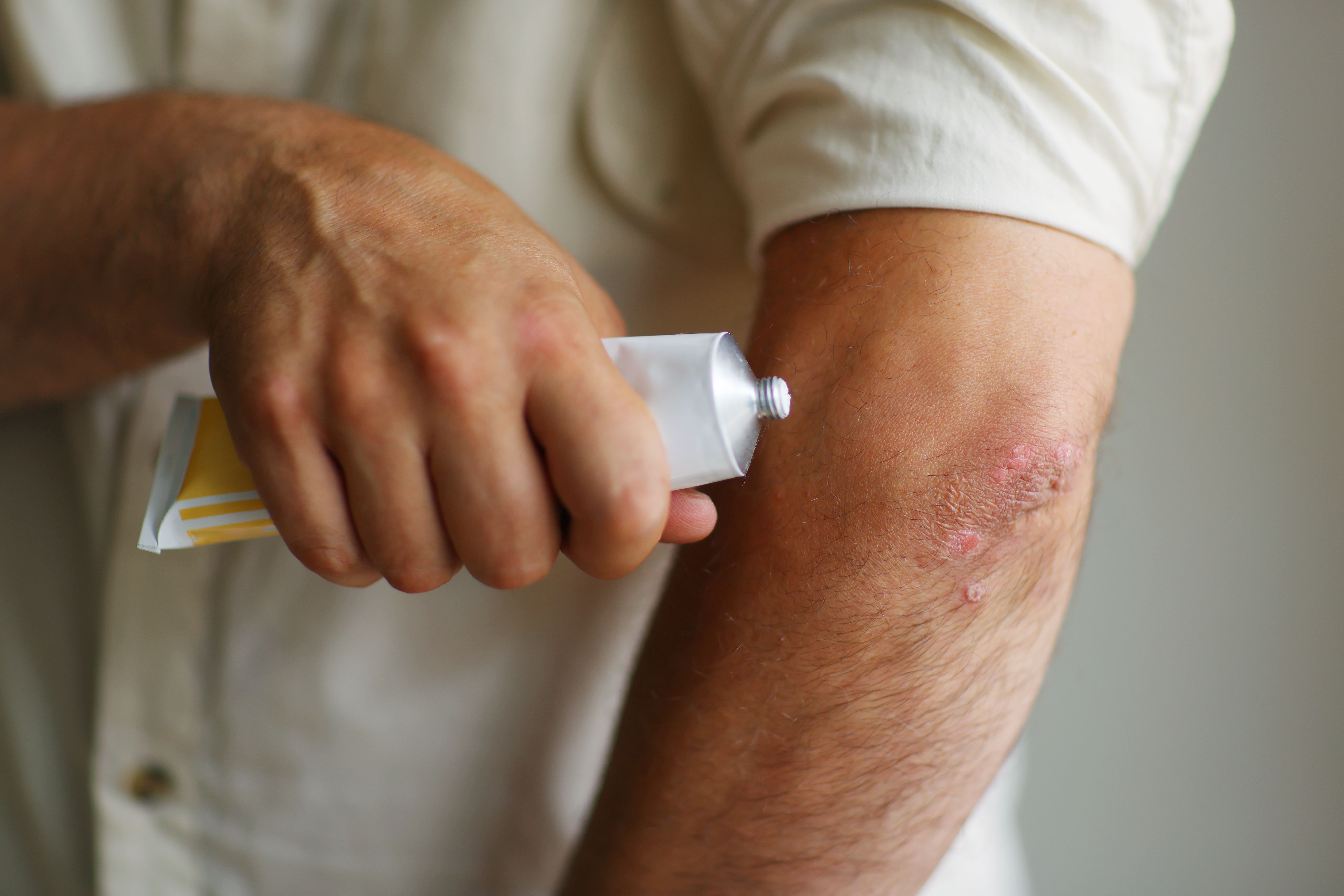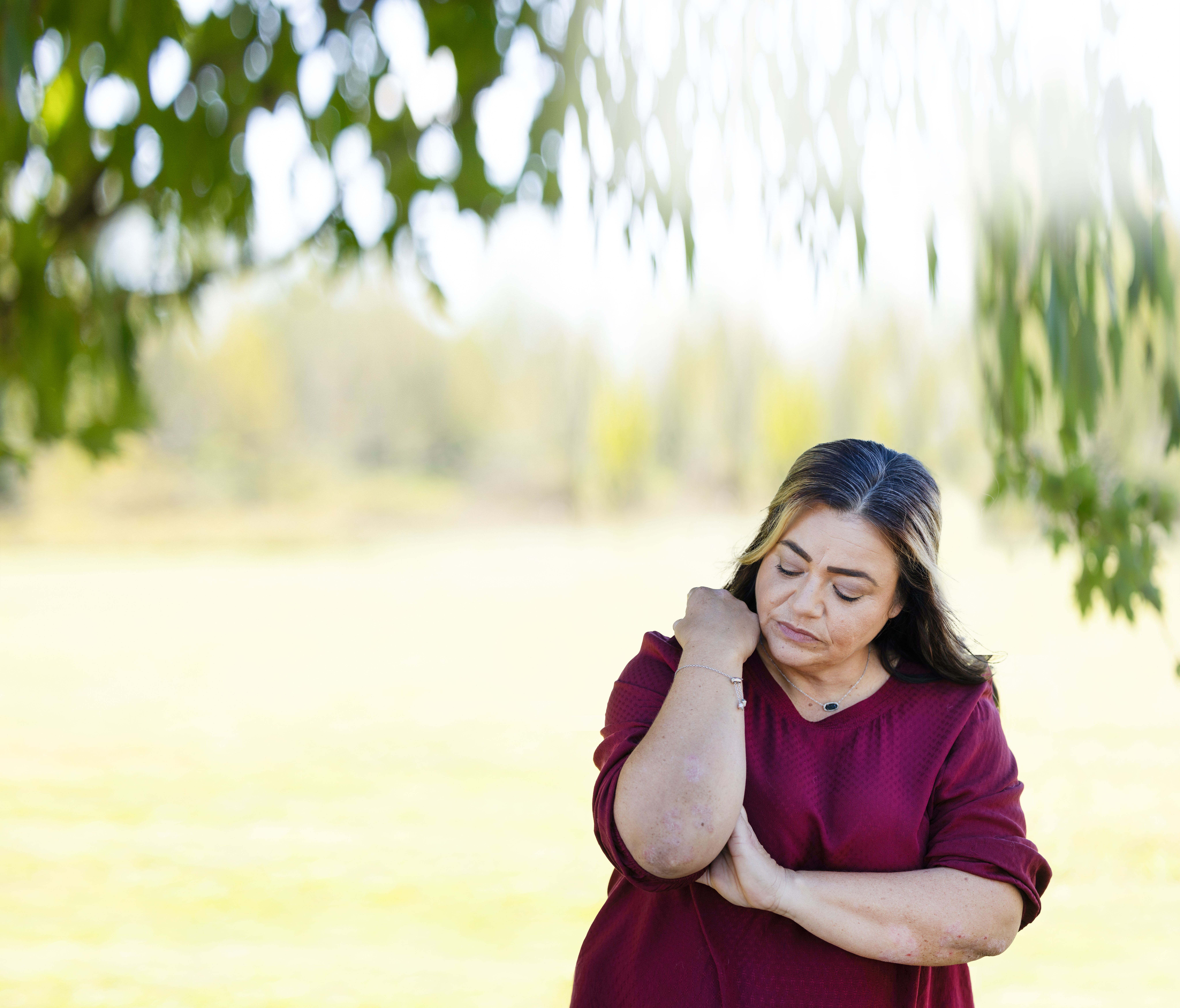- Case-Based Roundtable
- General Dermatology
- Eczema
- Chronic Hand Eczema
- Alopecia
- Aesthetics
- Vitiligo
- COVID-19
- Actinic Keratosis
- Precision Medicine and Biologics
- Rare Disease
- Wound Care
- Rosacea
- Psoriasis
- Psoriatic Arthritis
- Atopic Dermatitis
- Melasma
- NP and PA
- Skin Cancer
- Hidradenitis Suppurativa
- Drug Watch
- Pigmentary Disorders
- Acne
- Pediatric Dermatology
- Practice Management
- Prurigo Nodularis
- Buy-and-Bill
Feature
Article
Clinician and Patient Perspective: Tapinarof Cream for Plaque Psoriasis
Mona Shahriari, MD, and a plaque psoriasis patient provide insights into the mechanism of action and benefits of tapinarof cream 1% as a nonsteroidal topical.
Olga/AdbeStock

Dermavant’s tapinarof cream 1% (Vtama) was approved by the US Food and Drug Administration (FDA) in May 2022 and continues to be a useful tool in dermatology clinician’s armamentarium.1 As an aryl hydrocarbon receptor agonist and a steroid-free topical treatment, tapinarof cream provides dermatology clinicians the ability to prescribe their patients a nonsteroidal topical for those who may not respond well to other available psoriasis topicals.2
To better understand the significance of tapinarof cream and how it continues to provide patients relief 2 years after its approval, Mona Shahriari, MD, FAAD, reviews the limitations of topical corticosteroids in chronic skin conditions, how clinician preferences between topical steroidals and nonsteroidals have changed, the mechanism of action of tapinarof cream, what the future holds for nonsteroidal topicals, and more . Shahriari is an assistant clinical professor of dermatology at the Yale School of Medicine, the associate director of clinical trials at Central Connecticut Dermatology Research, and a Dermatology Times Editorial Advisory Board member.
To offer an additional perspective on tapinarof cream for plaque psoriasis, Dermatology Times also spoke to Beth, a patient who has had debilitating plaque psoriasis for 20 years. Beth provides her experience with her psoriasis affecting her daily life and her journey of trying numerous therapeutic agents to treat her plaque psoriasis.
Q&A With Mona Shahriari, MD, FAAD
Mona Shahriari, MD, FAAD
Credit: Central Connecticut Dermatology Research

Dermatology Times: What are some of your main concerns regarding topical steroidal creams for chronic skin conditions?
Shahriari: Topicals are a cornerstone when it comes to treating chronic skin disease. They can be used as monotherapy or in combination with a systemic agent to help control the signs and symptoms of chronic skin disease. But topical corticosteroids do come with some limitations. For starters, they are broadly immunosuppressive and not targeted for specific skin diseases. Also, there are limitations on the duration of use due to concerns about tachyphylaxis, as well as unwanted local and systemic adverse events due to long-term continuous use. Finally, they cannot be safely used on all affected areas due to concerns about local side and systemic side effects, especially when used in sensitive areas. In order to mitigate the latter, we oftentimes give patients multiple topical steroids depending on the body site that is affected. This can lead to complex regimens that are difficult for patients to follow and ultimately lead to non-compliance and inadequate control of the chronic skin condition.
Dermatology Times: In your experience, how have you seen the change in preference from topical steroidals to nonsteroidals?
Shahriari: Over the past several years, I have witnessed a real shift in how plaque psoriasis is treated; however, like all disease states, there is always room for additional growth and innovation. Given the limitations of our topical steroids, and concerns about steroid withdrawal syndrome on the part of patients, there has been much interest in using topical non-steroidals for the management of plaque psoriasis. The long-term safety of non-steroidal agents and their ability to be used on multiple affected areas has been very appealing and they have been a welcome addition to our psoriasis therapy toolbox.
Dermatology Times: What can non-steroidal topicals achieve that steroidals can’t?
Shahriari: Nonsteroidal topicals, like VTAMA cream, have really challenged the treatment paradigm and I have seen a shift in my personal dermatology practice where I reach for VTAMA over topical corticosteroids. VTAMA cream is a prescription once-daily, cosmetically elegant, steroid-free cream that is indicated for the topical treatment of plaque psoriasis in adults. Sometimes my patients need multiple prescriptions to treat their plaque psoriasis. But with VTAMA cream I can simplify their treatment regimen with one product that can be safely used once daily, on any affected area, for as long as the patient needs it, to effectively treat their plaque psoriasis. This is really a big step forward in the plaque psoriasis treatment landscape.
Dermatology Times: What is the mechanism of action of tapinarof cream 1%?
Shahriari: As an aryl hydrocarbon receptor (AhR) agonist, VTAMA cream is the first prescription topical plaque psoriasis treatment in its class. It’s also the first novel topical molecule to be approved in more than 25 years for plaque psoriasis treatment.
The specific mechanisms by which VTAMA cream exerts its therapeutic action in psoriasis patients are unknown. However, aryl hydrocarbon receptors are ligand-dependent receptors that are present in the skin, and they play an important role in homeostasis. In plaque psoriasis, the natural balance of the skin is disrupted. It is thought that AhR signaling may help restore the order and balance to this disruption. In preclinical studies for psoriasis, tapinarof has been shown to decrease inflammation, normalize skin barrier proteins, and boost antioxidants.
Dermatology Times: Do you have examples of patients who are performing well on non-steroidal topicals who previously tried steroidals?
Shahriari: I have more patients than I can count who had previously tried topical steroids for their plaque psoriasis who are now doing well on non-steroidal topicals like VTAMA. They were doing ok on their topical steroids, but the unifying theme was that the regimens were too complex to maintain over the long term, and as soon as they stopped the topical steroid, their psoriasis came right back. They love that this topical is once daily, can be safely used anywhere, and when they stop, the psoriasis stays away for an extended period of time. With VTAMA, they feel empowered to effectively treat their plaque psoriasis.
Seeing these success stories firsthand has led to a paradigm shift in my personal practice where I find myself reaching for the topical non-steroidal over the topical steroid whenever possible.
Dermatology Times: How do you anticipate the future of non-steroidal topicals changing for chronic skin conditions such as psoriasis or atopic dermatitis?
Shahriari: As someone who sees the physical and emotional impact that chronic skin conditions can have on patients daily, I’m excited about the innovations we’re witnessing within the topical treatment landscape. We have been complacent for far too long and there really hasn’t been a non-steroidal option that has given us enough of a reason to change our prescribing patterns. However, the topical non-steroidal revolution has so much potential for patients with plaque psoriasis, atopic dermatitis, and other inflammatory skin diseases. Moreover, our topical options for pediatric and adolescent patients have been very limited and our newer topical non-steroidals have the potential to offer our younger patients effective options beyond topical steroids. I believe our next generation non-steroidal topicals could finally be the catalyst for a real paradigm shift in the treatment of plaque psoriasis and atopic dermatitis in adults.
Having a range of treatment options ensures that I’m able to cater to the needs of my patients, and I encourage my peers to also look intothe benefits of nonsteroidal topical options.
Q&A With Beth, a Patient With Plaque Psoriasis
Beth, a patient with plaque psoriasis
Credit: Dermavant Sciences

Dermatology Times: Can you please provide background on your plaque psoriasis diagnosis and how it has progressed?
Beth: After giving birth to my eldest daughter, I noticed a small spot on my elbow, which I initially dismissed as dry skin. However, the condition worsened after the birth of my second daughter, and my plaques spread to other areas, like my ankles. That's when I decided to seek help from a dermatologist, who diagnosed me with plaque psoriasis.
Dermatology Times: How has psoriasis affected your personal interactions, work experiences, family life, and mental health?
Beth: Plaque psoriasis had a profound impact on every aspect of my life. It changed my personality — turning me from an outgoing extrovert to an introverted person plagued by self-consciousness. I often found myself constantly strategizing ways to hide my skin, which affected my interactions with friends, family, and colleagues.
Navigating being a social worker became an even greater challenge when confronted with uniforms that exposed my skin, triggering discomfort and self-doubt. The constant need to conceal my skin and the fear of judgment from others took a toll on my mental health, leading to anxiety, depression, and a sense of isolation.
Dermatology Times: What treatments did you initially try and what were the results?
Beth: During the early stages of my diagnosis, I tried different treatment options that were recommended by dermatologists. I was eager to find relief, so I tried everything from topical creams to oral medications. Unfortunately, the results were often disappointing, with minimal improvement in my symptoms and occasional side effects that made me feel even worse. After 11 years of frustration and lack of progress, I stopped seeking medical help and managed my symptoms as best as I could on my own.
Dermatology Times: What was the state of your mental health when you stopped all treatments and stopped seeing your dermatologist?
Beth: Stopping treatments and discontinuing visits to my dermatologist was a difficult decision. At first, I felt relieved, but then I started worrying about managing my skin condition on my own. As it got worse, I became more withdrawn and anxious about people noticing. Even everyday things like wearing shorts or applying for jobs became stressful. I ended up neglecting self-care and isolating myself, feeling trapped in a cycle of shame and misery. Reaching my lowest point with my mental health was my wake-up call to take action.
Dermatology Times: What treatment regimen finally helped to control your psoriasis?
Beth: Encouraged by the positive experience shared online by others, I felt empowered to talk to my dermatologist about topical treatment for plaque psoriasis in adults called VTAMA (tapinarof) cream, 1%, which made a significant difference in managing my plaque psoriasis. After using it once a day for four weeks, I noticed improvement in my plaques. With continued use over several months, my skin has cleared up significantly. Today, VTAMA cream remains an important part of my treatment plan, helping me manage my plaque psoriasis. There are even periods of time when I don't need to use it daily because my plaques are under control. With clearer skin, I'm gradually regaining confidence and feeling more comfortable in my own skin, paving the way for a more fulfilling life.
What is your experience with prescribing tapinarof cream 1% for your patients with plaque psoriasis? Email us at DTEditor@mmhgroup.com for an opportunity to be featured.
References
- FDA approves Dermavant’s VTAMA (tapinarof) cream, 1% for the treatment of plaque psoriasis in adults: first topical novel chemical entity launched for psoriasis in the U.S. in 25 years. News release. Dermavant Sciences. May 24, 2022. Accessed April 26, 2024. https://dermavant.com/u-s-fda-approves-our-novel-topical-treatment-for-adults-with-plaque-psoriasis/
- Lebwohl M, Khattri S. Nonsteroidal topical treatments for plaque psoriasis. Dermatology Times. April 4, 2024. Accessed April 26, 2024. https://www.dermatologytimes.com/view/nonsteroidal-topical-treatments-for-plaque-psoriasis





